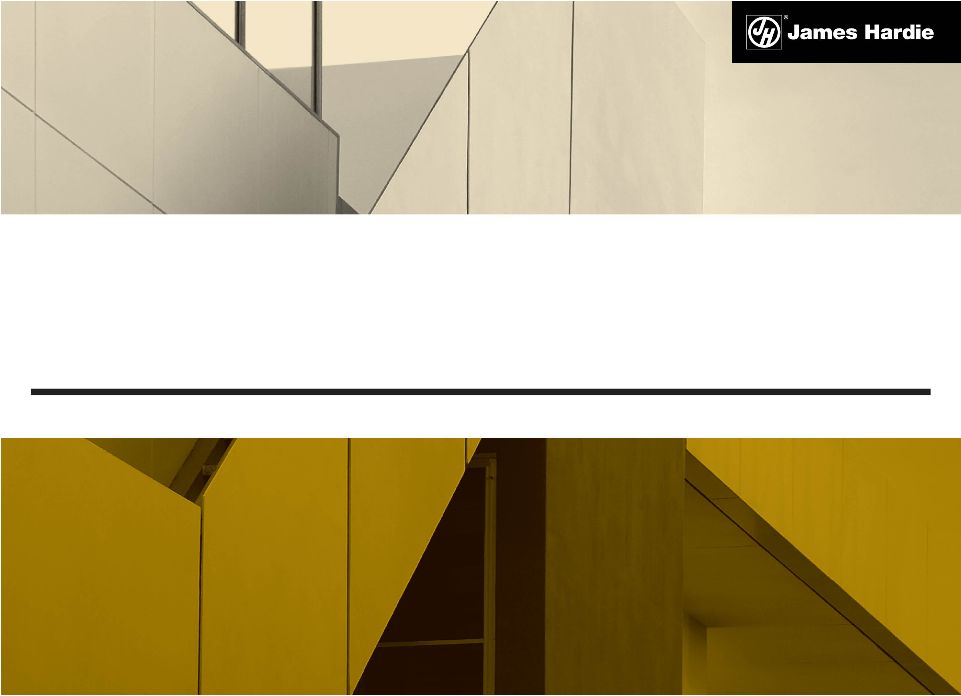 INVESTOR
PRESENTATION March 2012
Exhibit 99.13 |
 INVESTOR
PRESENTATION March 2012
Exhibit 99.13 |
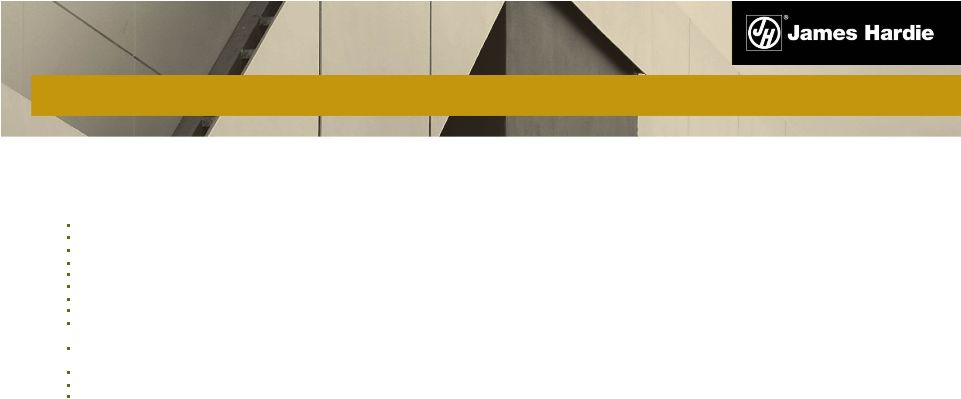 2
DISCLAIMER
This Management Presentation contains forward-looking statements.
James Hardie may from time to time make forward-looking statements in its periodic reports filed with or furnished to the
SEC, on Forms 20-F and 6-K, in its annual reports to
shareholders, in offering circulars, invitation memoranda and prospectuses, in media releases and other written materials and in oral
statements made by the
company’s officers, directors or employees to analysts, institutional investors, existing and potential lenders, representatives of the media and others. Statements that are
not historical facts are forward-looking statements and such
forward-looking statements are statements made pursuant to the Safe Harbor Provisions of the Private Securities Litigation Reform
Act of 1995. Examples of forward-looking statements include:
statements about the
company’s future performance;
projections of the company’s
results of operations or financial condition; statements regarding the
company’s plans, objectives or goals, including those relating to strategies, initiatives, competition, acquisitions, dispositions and/or our products;
expectations concerning the costs associated with the suspension or
closure of operations at any of the company’s plants and future plans with respect to any such plants;
expectations that the
company’s credit facilities will be extended or renewed;
expectations concerning dividend payments and share buy-backs; statements concerning the
company’s corporate and tax domiciles and potential changes to them, including potential tax charges;
statements regarding tax liabilities and related audits, reviews and
proceedings; statements as to the possible consequences of proceedings brought
against the company and certain of its former directors and officers by the Australian Securities and Investments
Commission (ASIC);
expectations about the timing and amount of contributions to the
Asbestos Injuries Compensation Fund (AICF), a special purpose fund for the compensation of proven Australian
asbestos-related personal injury and death claims; expectations concerning indemnification obligations; statements about product or environmental liabilities; and statements about economic conditions, such as economic or housing
recovery, the levels of new home construction, unemployment levels, changes or stability in housing values, the
availability of mortgages and other financing, mortgage and other
interest rates, housing affordability and supply, the levels of foreclosures and home resales, currency exchange rates
and builder and consumer confidence.
Words such as
“believe,” “anticipate,” “plan,” “expect,” “intend,” “target,” “estimate,” “project,” “predict,” “forecast,” “guideline,” “aim,” “will,” “should,” “likely,” “continue” and similar expressions
are intended to identify forward-looking statements but are not the
exclusive means of identifying such statements. Readers are cautioned not to place undue reliance on these forward-looking
statements and all such forward-looking statements are qualified in
their entirety by reference to the following cautionary statements.
Forward-looking statements are based on the company’s current expectations, estimates and assumptions and because forward-looking statements address future results, events and conditions,
they, by their very nature, involve inherent risks and uncertainties,
many of which are unforeseeable and beyond the company’s control. Such known and unknown risks, uncertainties and other
factors may cause actual results, performance or other achievements to
differ materially from the anticipated results, performance or achievements expressed, projected or implied by these
forward-looking statements. These factors, some of which are
discussed under “Risk Factors” in Section 3 of the Form 20-F filed with the US Securities and Exchange Commission on 29 June
2011, as amended by the Form 20-F/A filed on 14 July 2011,
include, but are not limited to: all matters relating to or arising out of the prior manufacture of products that contained asbestos by
current and former James Hardie subsidiaries; required contributions to
the AICF, any shortfall in the AICF and the effect of currency exchange rate movements on the amount recorded in the
company’s financial
statements as an asbestos liability; governmental loan facility to the AICF; compliance with and changes in tax laws and treatments; competition and product pricing in the
markets in which the company operates; the consequences of product
failures or defects; exposure to environmental, asbestos or other legal proceedings; general economic and market conditions;
the supply and cost of raw materials; possible increases in competition
and the potential that competitors could copy the company’s products; reliance on a small number of customers; a
customer’s inability to pay;
compliance with and changes in environmental and health and safety laws; risks of conducting business internationally; compliance with and changes in laws and
regulations; the effect of the transfer of the company’s corporate domicile from The Netherlands to Ireland to become an Irish SE including employee relations, changes in corporate governance
and potential tax benefits; currency exchange risks; dependence on
customer preference and the concentration of the company’s customer base on large format retail customers, distributors and
dealers; dependence on residential and commercial construction markets;
the effect of adverse changes in climate or weather patterns; possible inability to renew credit facilities on terms
favorable to the company, or at all; acquisition or sale of businesses
and business segments; changes in the company’s key management personnel; inherent limitations on internal controls; use of
accounting estimates; and all other risks identified in the company’s reports filed with Australian, Irish and US securities agencies and exchanges (as appropriate). The company cautions you that
the foregoing list of factors is not exhaustive and that other risks
and uncertainties may cause actual results to differ materially from those in forward-looking statements. Forward-looking
statements speak only as of the date they are made and are statements
of the company’s current expectations concerning future results, events and conditions.
|
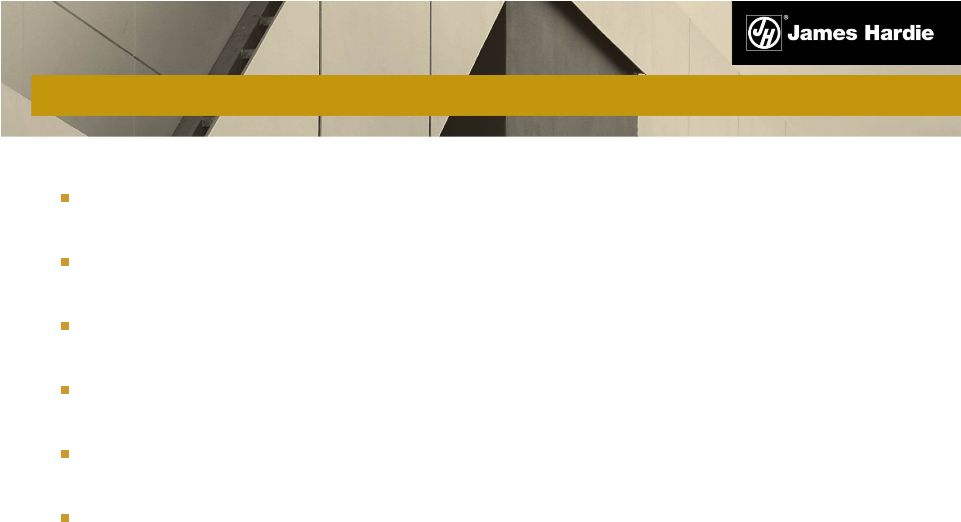 3
Business overview
USA and Europe Fibre Cement
Asia Pacific Fibre Cement
Group Outlook
Summary
Appendix
AGENDA
In
this
Management
Presentation,
James
Hardie
may
present
financial
measures,
sales
volume
terms,
financial
ratios,
and
Non-US
GAAP
financial
measures
included
in
the
Definitions
section
of
this
document
starting
on page 32. The company presents financial measures that it believes are
customarily used by its Australian investors. Specifically, these financial measures, which are equivalent to or derived from certain US GAAP
measures
as
explained
in
the
definitions,
include
“EBIT”,
“EBIT
margin”,
“Operating
profit”
and
“Net
operating
profit”.
The
company
may
also
present
other
terms
for
measuring
its
sales
volumes
(“million
square
feet
or
mmsf”
and “thousand square feet or msf”); financial ratios (“Gearing ratio”, “Net
interest expense cover”, “Net interest paid cover”, “Net debt payback”, “Net debt (cash)”); and Non-US GAAP financial measures (“EBIT
excluding asbestos, ASIC expenses and asset impairments”, “EBIT margin excluding asbestos,
ASIC expenses and asset impairments”, “Net operating profit excluding asbestos, ASIC expenses, asset impairments and
tax adjustments”, “Diluted earnings per share excluding asbestos, ASIC expenses, asset
impairments and tax adjustments”, “Operating profit before income taxes excluding asbestos and asset impairments”, “Effective
tax
rate
excluding
asbestos,
asset
impairments
and
tax
adjustments”,
“EBITDA”
and
“General
corporate
costs
excluding
domicile
change
related
costs”).
Unless
otherwise
stated,
results
and
comparisons
are
of
the
1
quarter
and
current
fiscal
year
versus
the
1
quarter
of
the
prior
fiscal
year.
st
st |
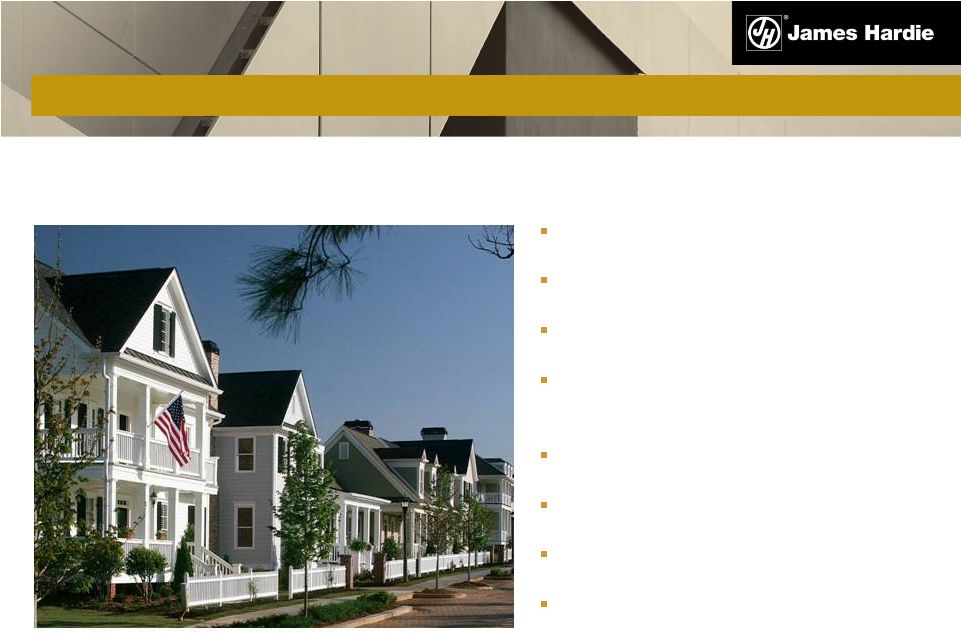 4
Annual net sales US$1.2b
Total assets US$1.4b
Net cash US$25.8m
Operations in North America, Asia
Pacific and Europe
2,500 employees
Market cap US$3.2b
S&P/ASX 100 company
NYSE ADR listing
Note: Net sales (annualised but not seasonally adjusted), total assets and net cash are at 31 December
2011. Total assets exclude asbestos compensation.
JAMES HARDIE: A GROWTH FOCUSED COMPANY |
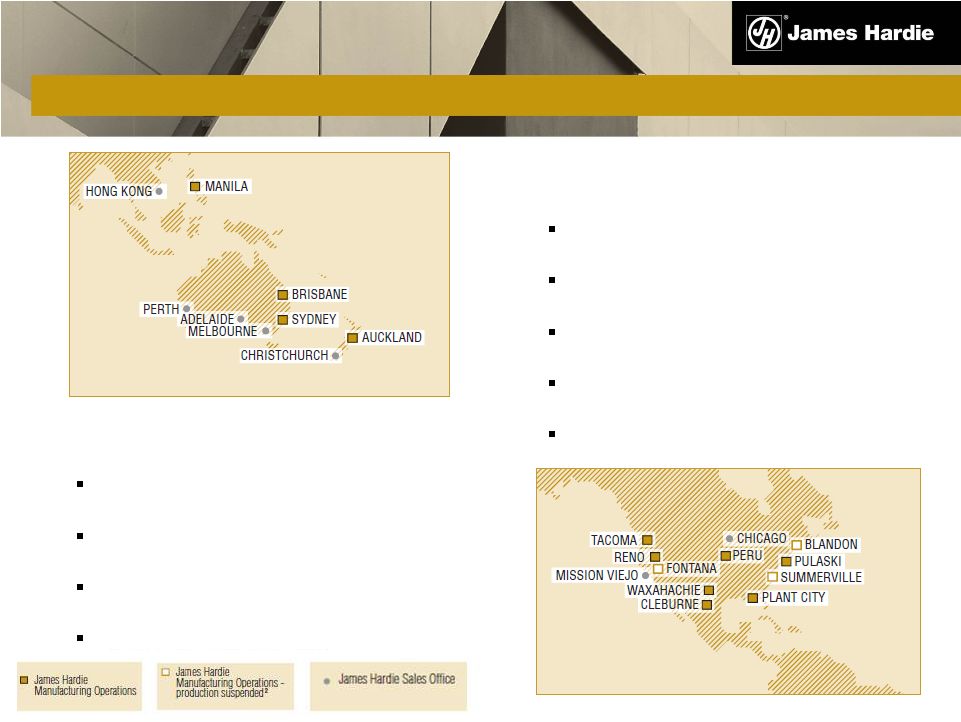 5
JAMES HARDIE –
A WORLD LEADER IN FIBRE CEMENT
USA Fibre Cement Products
Siding
Soffit
Fascia
Trim
Backerboard
Asia Pacific Fibre Cement Products
Residential siding
Commercial exteriors
Flooring
Ceiling and internal walls |
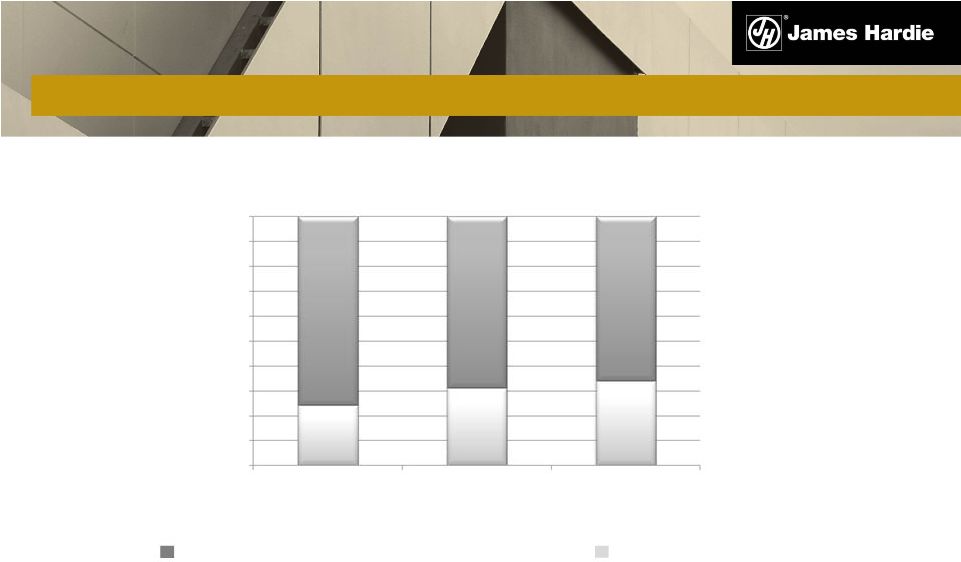 6
GLOBAL -
BUSINESS PORTFOLIO
At and for the nine months ended 31 December 2011
* EBIT –
Excludes Research and Development EBIT and Asbestos-related items
USA and Europe Fibre Cement
Asia-Pacific Fibre Cement
66%
34%
76%
24%
69%
31%
Volume
Sales
EBIT* |
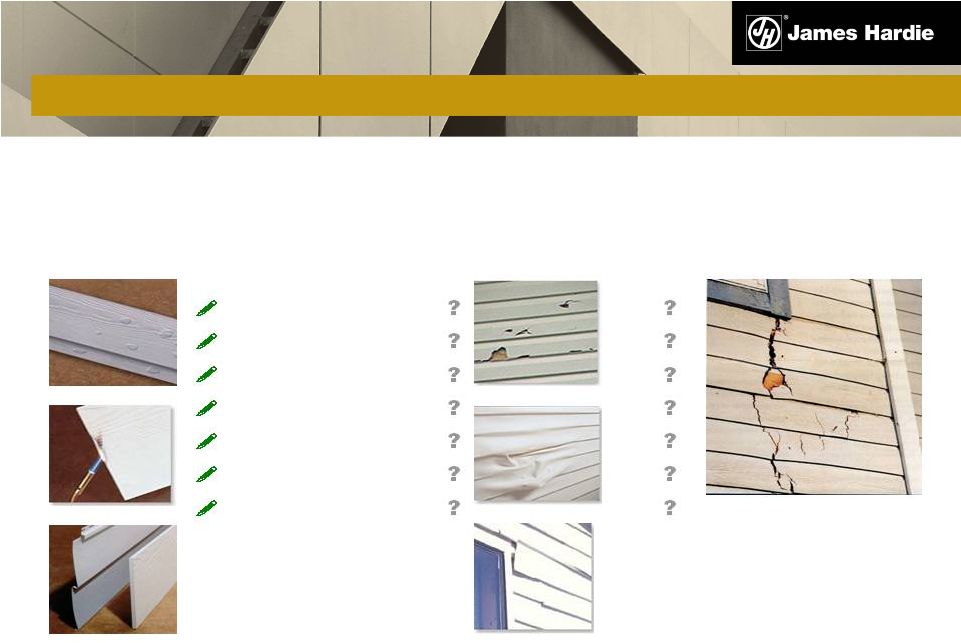 7
Fibre cement is more durable than wood and engineered wood, and looks and
performs better than vinyl, and cheaper and quicker to build with than brick
Vinyl
Fire resistant
Hail resistant
Resists warping
Resists buckling
Colour lasts longer
Dimensional stability
Can be repainted
Fibre cement
Engineered wood
FIBRE CEMENT –
SUPERIOR PRODUCT PERFORMANCE |
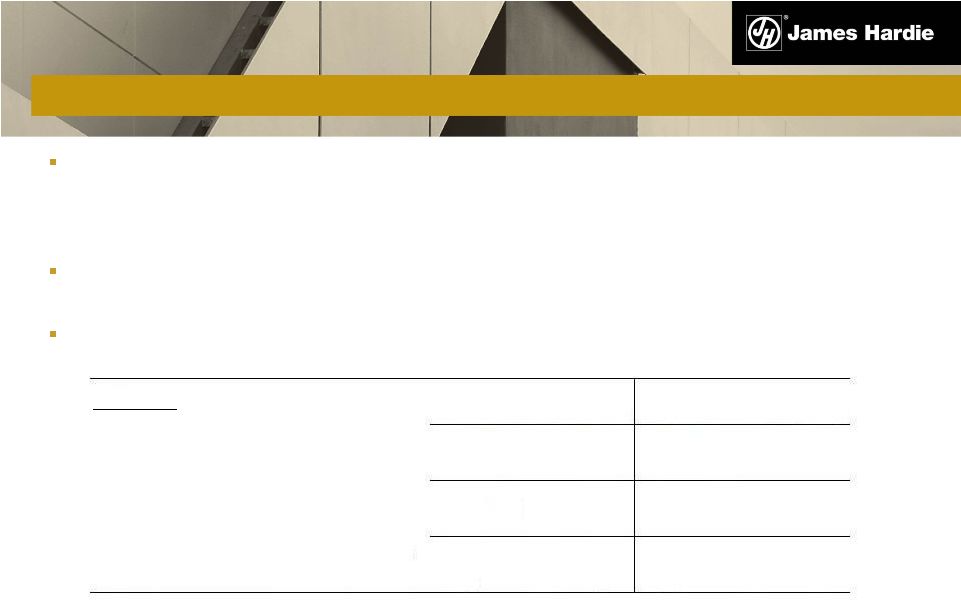 8
3
rd
quarter
operating
results
reflected
higher
sales
volume
(in
the
US
business),
improved
manufacturing performance, lower general corporate costs and an appreciation of Asia Pacific
businesses’
currencies compared to the US dollar, partially offset by an unfavorable product mix and
geographic mix in US sales.
As of 31 December 2011, the company had repurchased 3.4 million of shares at an aggregate cost of
A$19.1 million (US$19.0 million) and an average price paid per share of A$5.59 (US$5.55)
Interim dividend of US4.0 cents per security, or US$17.4 million, was paid 23 January 2012
1
Comparisons are of the 3
quarter and nine months of the current fiscal year versus the
3 quarter and nine months of the prior fiscal year
2
The nine months results of the prior year included a charge of US$345.2 million resulting from the
dismissal by the Federal Court of Australia of RCI’s appeal of the ATO’s disputed
1999 assessment. Readers are referred to Note 10 of the consolidated financials for further information
2
GROUP OVERVIEW
1
Q3
Q3
%
9 Months
9 Months
%
FY 2012
FY 2011
Change
FY 2012
FY 2011
Change
Net operating (loss) profit
(4.8)
(26.4)
82
123.6
(345.2)
-
Net operating profit excluding asbestos, ASIC
expenses and tax adjustments
27.7
21.0
32
108.3
82.2
32
Diluted earnings per share excluding asbestos, ASIC
expenses and tax adjustments (US cents)
6.3
4.8
31
24.7
18.8
31
US$ Millions
nd
nd |
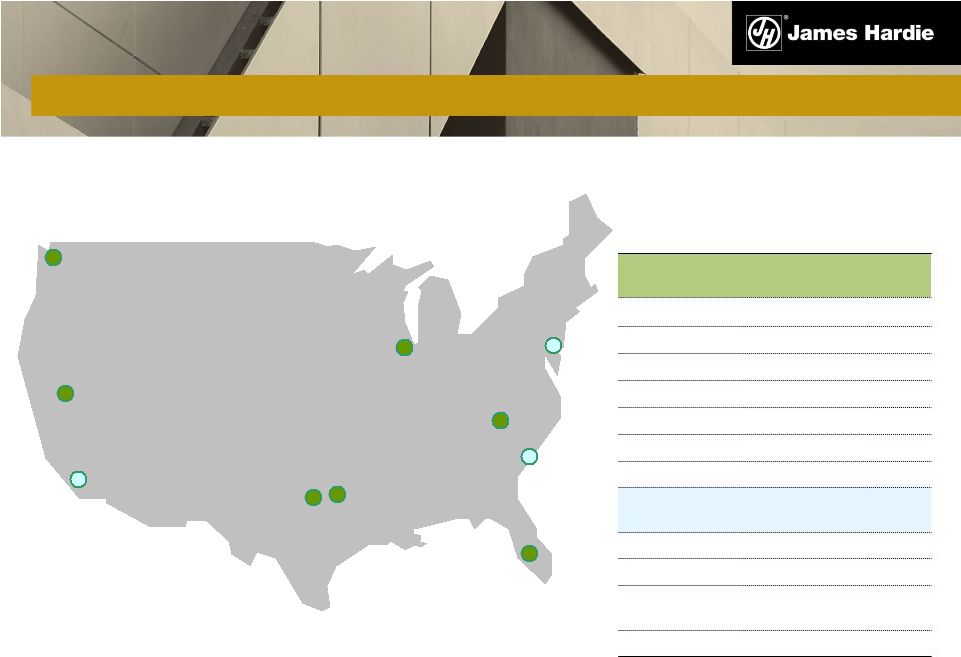 9
JH Plant Design Capacity
•
Tacoma, WA
Plant City, FL
Waxahachie, TX
Cleburne, TX
Peru,
IL
Blandon, PA
Summerville, SC
Pulaski, VA
•
Reno, NV
•
•
•
•
•
•
•
•
Fontana, CA
Plant locations
1
Production was suspended at the
Blandon plant in October 2007; at the
Summerville plant in November 2008;
and at the Fontana plant in December
2008
THE USA BUSINESS –
LARGEST FIBRE CEMENT PRODUCER IN NORTH AMERICA
Flat Sheet
Plants
Capacity
(mmsf)
Plants operating
Cleburne, Texas
500
Peru, Illinois
560
Plant City, Florida
300
Pulaski, Virginia
600
Reno, Nevada
300
Tacoma, Washington
200
Waxahachie, Texas
360
Plants suspended
Blandon, Pennsylvania
1
200
Fontana, California
1
180
Summerville, South
Carolina
190
Flat Sheet Total
3,390
1 |
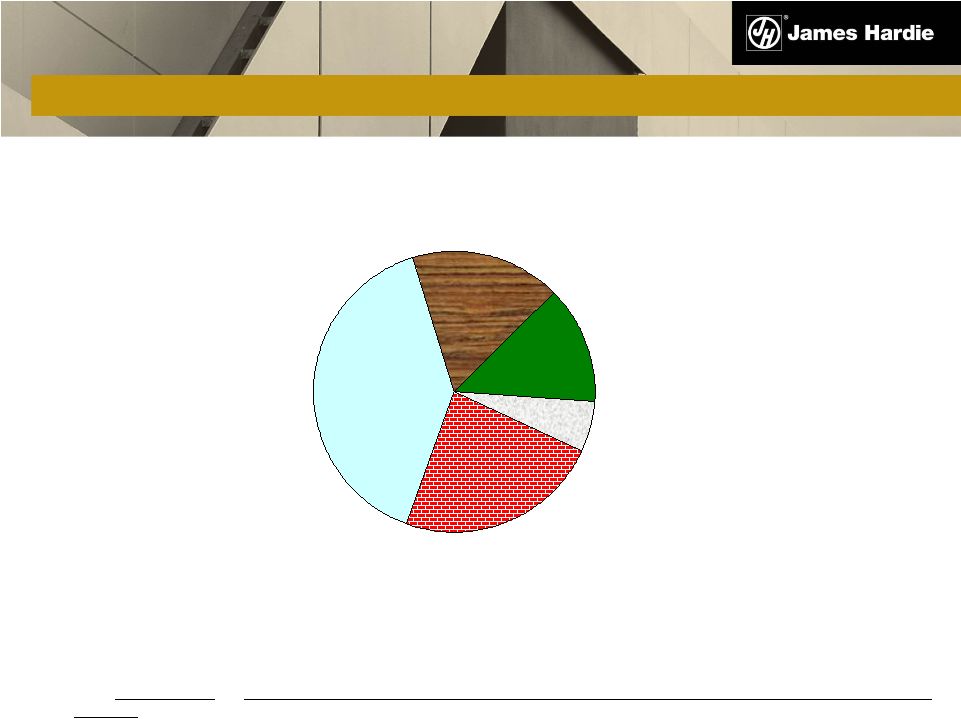 US
EXTERIOR CLADDING MARKET Note:
1) Market share figures reflect siding only; exclude fascia, soffits & trim; data reflects Repair
& Remodel and New Construction markets, combined. 2) Siding volumes exclude waste factors, a
change from previously reported numbers.
Sources:
NAHB
Builder
Practices
and
Consumer
Practices
Report
–
2008
Siding
and
Exterior
Wall
Finish,
adjusted
to
reflect
JH’s
estimate
for
FC
and
wood
categories.
Brick, Stone and
Other
23.5%
Stucco
6.0%
FC
13.5%
Wood
17.3%
Vinyl
39.7%
Large growth opportunity |
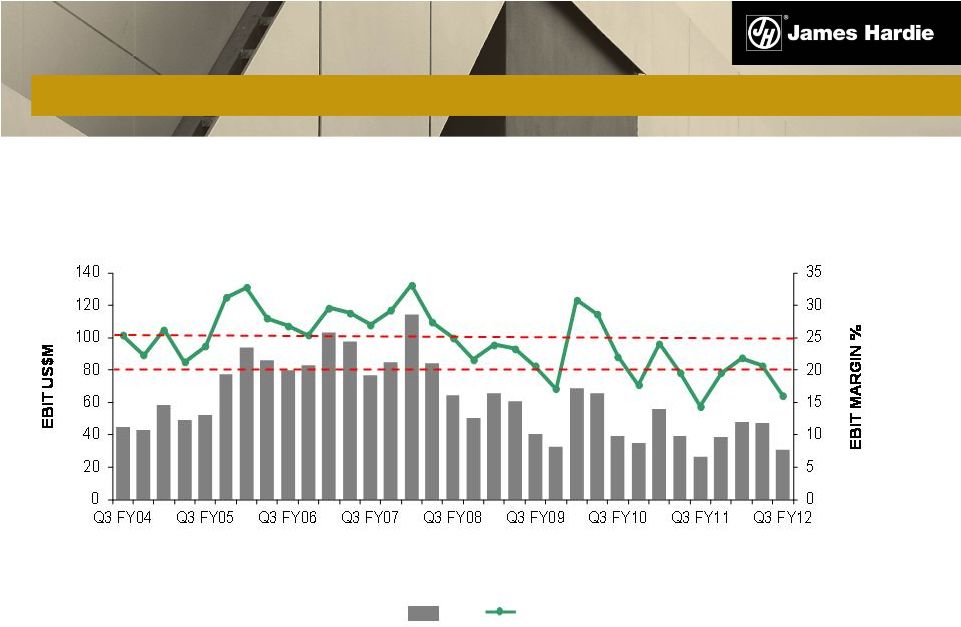 1
Excludes impairment charges of US$45.6 million in Q4 FY08
11
EBIT and EBIT Margin
EBIT
EBIT Margin
USA AND EUROPE FIBRE CEMENT
1 |
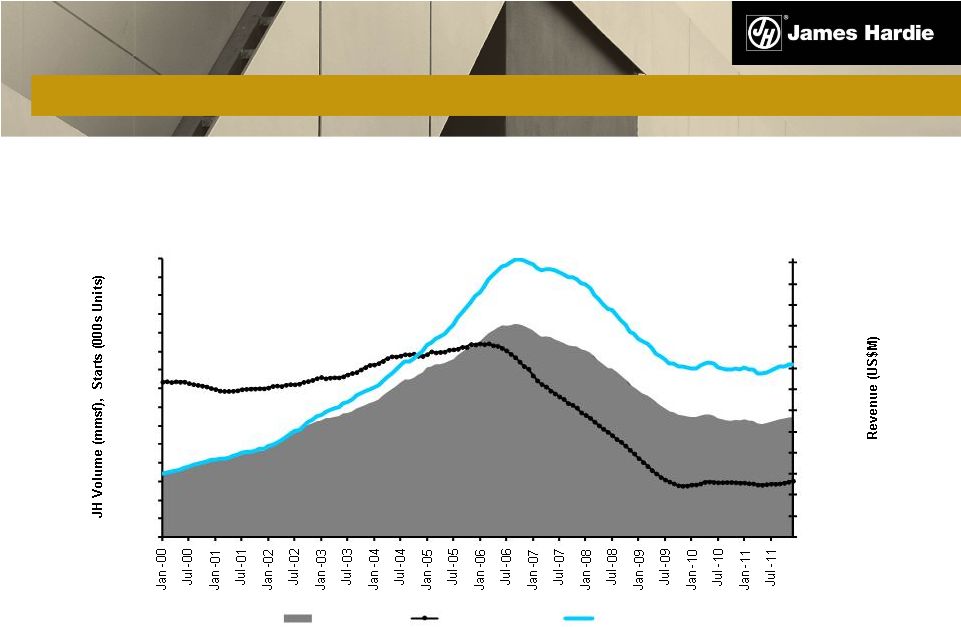 Rolling 12 month average of seasonally adjusted estimate of housing starts by US
Census Bureau 12
USA AND EUROPE FIBRE CEMENT
$0
$100
$200
$300
$400
$500
$600
$700
$800
$900
$1,000
$1,100
$1,200
$1,300
0
200
400
600
800
1,000
1,200
1,400
1,600
1,800
2,000
2,200
2,400
2,600
2,800
3,000
Top Line Growth
JH Volume
Housing Starts
JH Revenue |
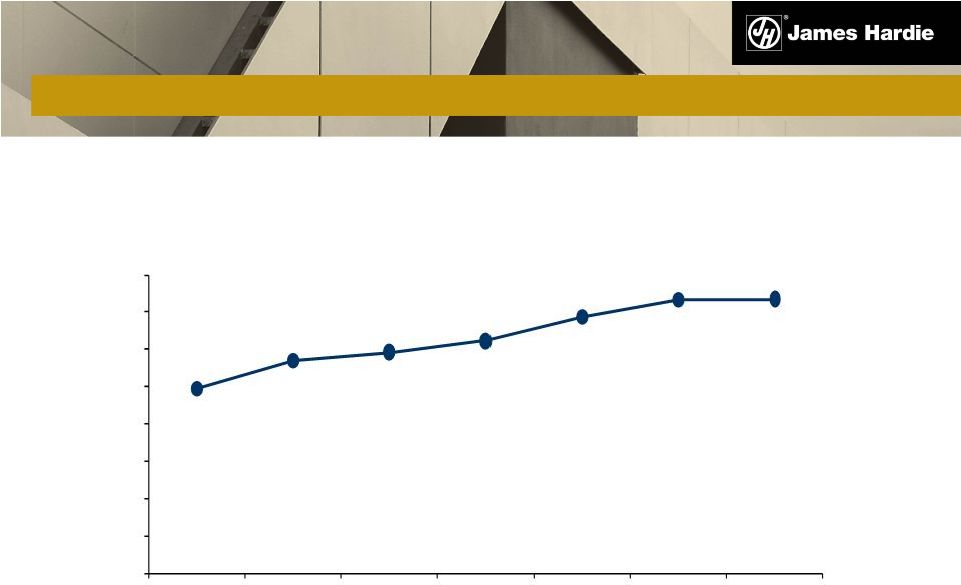 13
Average Net Sales Price (US dollars)
1
FY12
average
net
sales
price
represents
3
rd
quarter
year
to
date;
other
years
presented
are
for
the
full
year
1
US$654 per msf
USA AND EUROPE FIBRE CEMENT
360
400
440
480
520
560
600
640
680
FY06
FY07
FY08
FY09
FY10
FY11
Q3 FY12 |
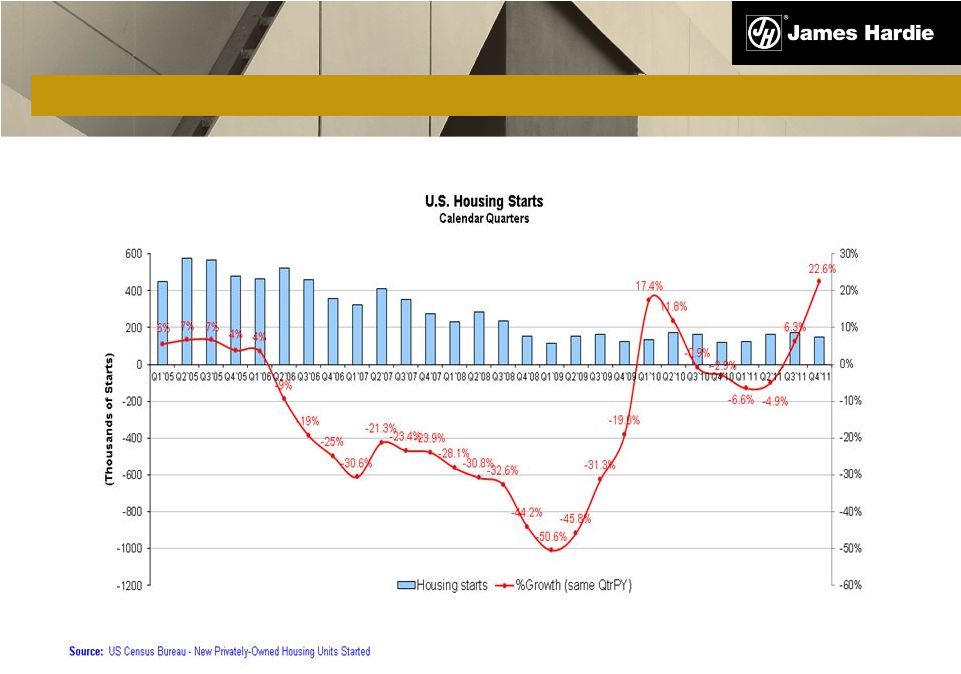 14
TOTAL USA HOUSING STARTS –
US CENSUS |
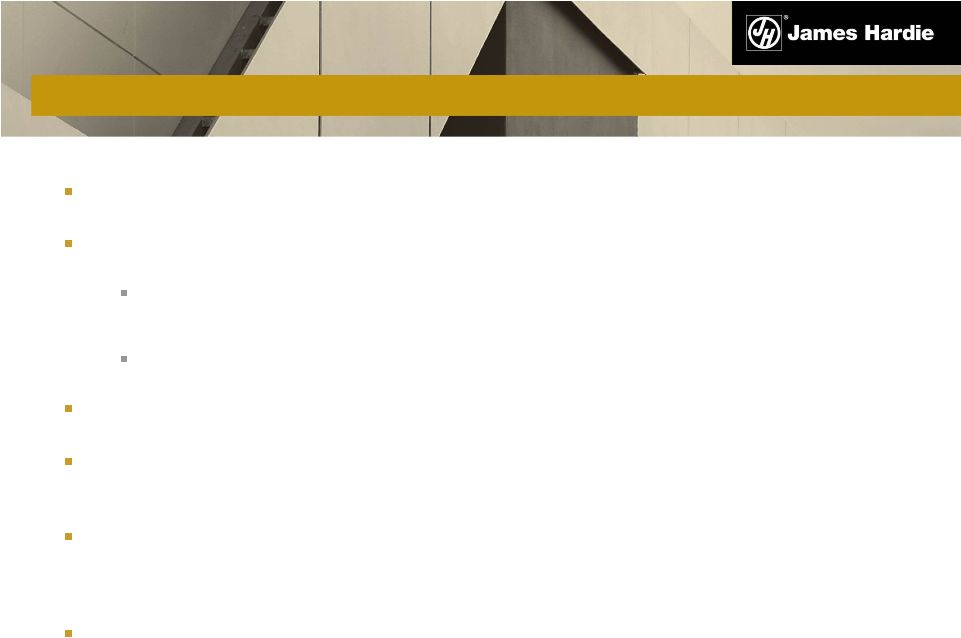 15
Focus on primary demand growth and cost management
Business re-set to balance supply and demand
production suspended at Blandon PA (November 2007), Summerville SC
(November 2008) plants and Fontana CA (December 2008)
corporate-wide review of activities, projects and cost-saving
opportunities Employee numbers in US business down >25% from peak in
2006 Continuing to invest in long term growth initiatives, such as
R&D and market development
Continuing to invest in market initiatives such as increased penetration of
Repair and Remodel and non-metro markets, new “job pack”
distribution
and rollout of products initiatives such as Colorplus and Artisan
Able to ‘flex up’
quickly if needed
RESPONSE TO US HOUSING DOWNTURN |
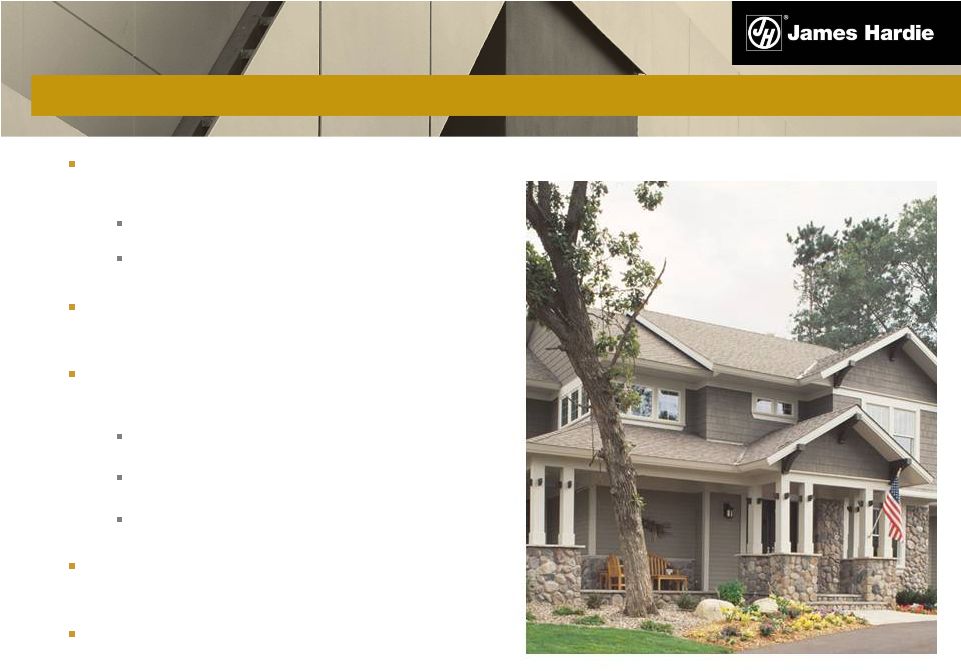 16
PRODUCT LEADERSHIP EXAMPLE –
COLORPLUS®
ColorPlus®
Collection (pre-painted siding and
trim):
Driving growth against vinyl in Northern USA
Launched in Western and Southern USA FY07
Higher value products with higher
revenue streams
Strategy
designed
to
reduce
‘on
the
wall’
cost
and close gap with vinyl siding
Supply of pre-painted exterior products
Reduce supply chain costs
Best practice installation
Channel increases revenue base and
gains incremental volume
End-user gets higher quality product
at reduced cost |
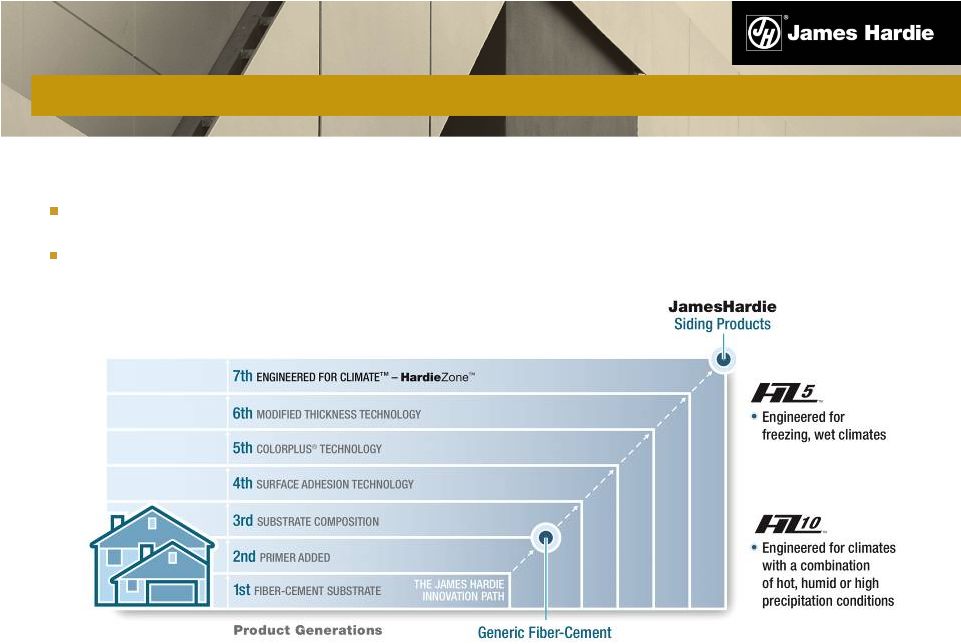 17
17
PRODUCT LEADERSHIP EXAMPLE –
HARDIEZONE™
SYSTEM
7 Generation versus 2
Generation generic fibre cement
The HardieZone™
System represents a logical extension of Hardie
technology
th
nd |
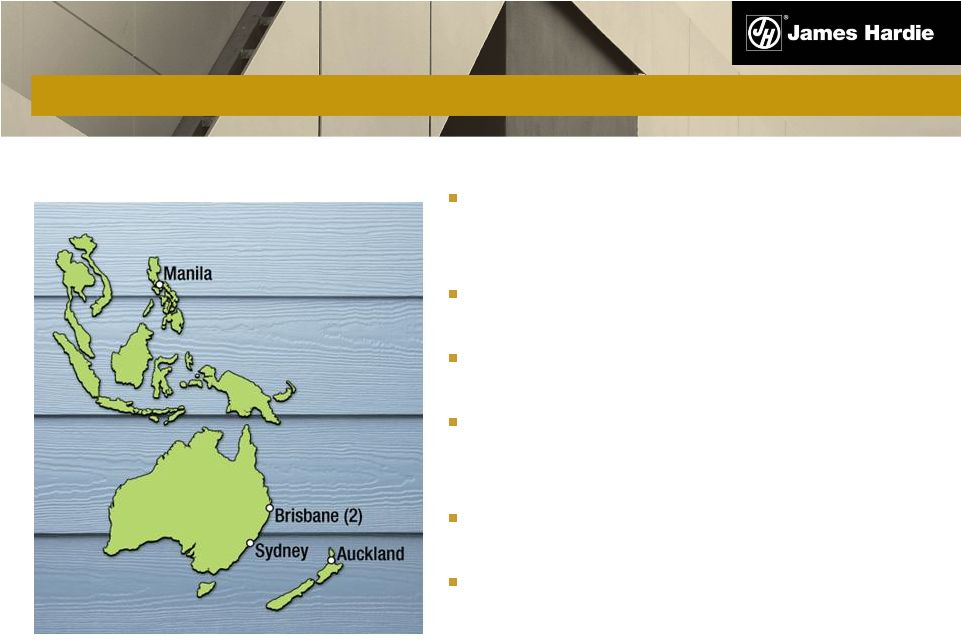 18
Five manufacturing plants in
Asia Pacific
Net sales US$382.5m
EBIT US$88m
Higher value differentiated
products
Lower delivered cost
Growth model
ASIA PACIFIC FIBRE CEMENT
Asia Pacific manufacturing facilities. Net Sales and EBIT as at
31 December 2011 and annualised, but not seasonally adjusted.
|
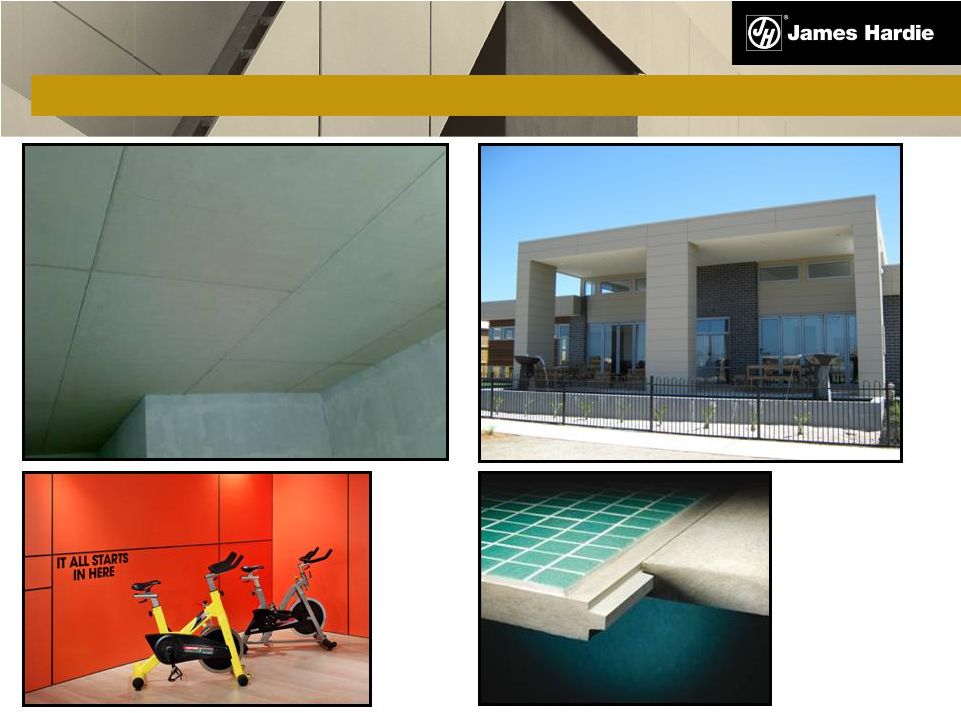 19
ASIA
PACIFIC
FIBRE
CEMENT
–
EXAMPLES
General purpose flooring
Exterior cladding
Philippines
Australia
New Zealand
Australia
Ceilings and partitions
Interior walls |
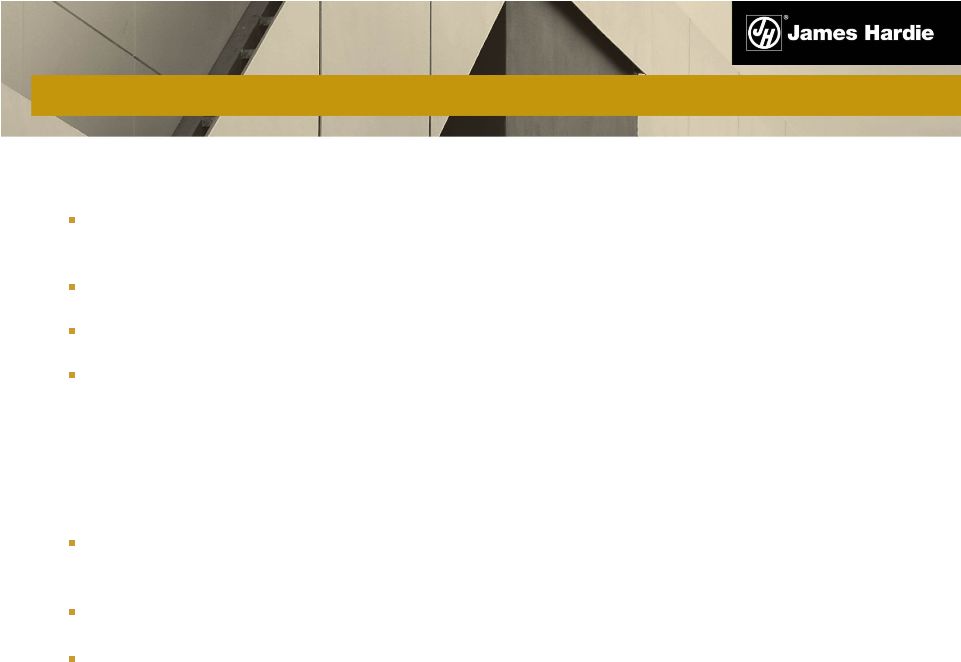 20
GROUP OUTLOOK
United States
Although industry activity and demand have stabilised, there remains no evidence of
a sustainable recovery
Pulp price index (NBSK) steadily declining, but remains at elevated levels
Freight costs continue to be high compared to prior year
Company
initiatives,
such
as
the
increased
penetration
of
repair
and
remodel
and
non-metro markets and our house pack strategies, remain on track to improve upon
the gains in fibre cement category share and the exterior cladding market achieved
this year
Asia Pacific
Australia: despite a recent cut in official interest rates, there is little confidence of an
immediate pick up in housing construction activity
New Zealand: activity in the housing construction industry remains subdued
Philippines: activity in new construction slowed in the quarter |
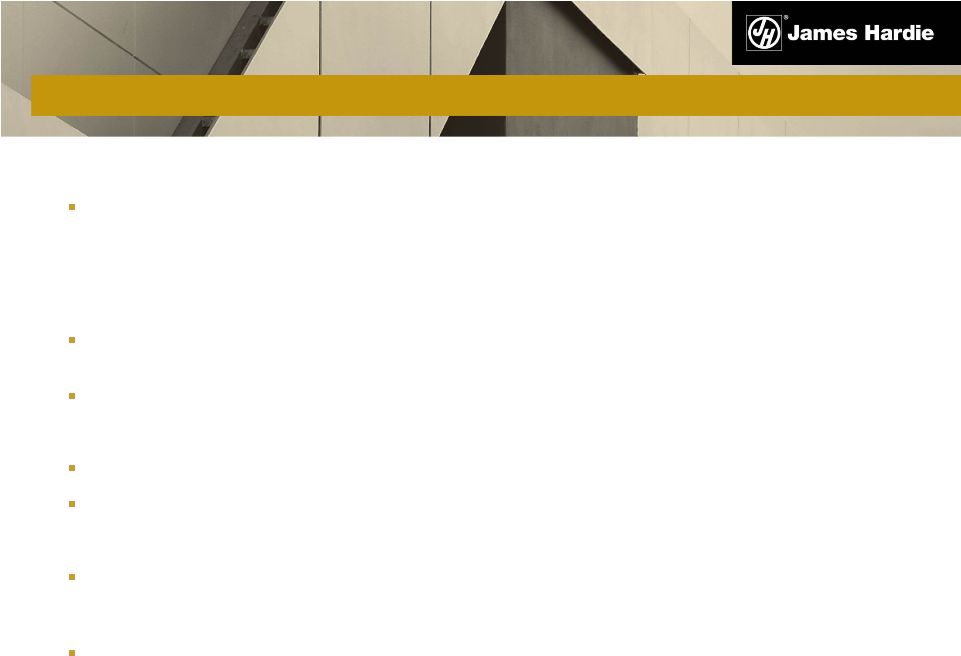 21
The reduced level of debt, along with a reduction in the number of company specific
contingencies
and
a
strengthened
confidence
in
the
business’
ability
to
adapt
and
meet
the
challenges of the low demand operating environment enabled the Board to announce in May
2011 the resumption of an active approach to capital management
Dividends
New policy to distribute between 20% and 30% of profits after tax (excluding asbestos
adjustments) in the form of ordinary dividends
Interim dividend of 4 US cents per security paid on 23 January 2012
Share buyback
On market share buyback of up to 5% of issued capital over 12 months commencing May 2011
As at 31 December 2011, the company had repurchased 3.4 million shares
ATO Amended Assessment
Following the resolution of the ATO/RCI dispute the ATO will refund US$265.8m. The
company will receive additional amounts representing overpaid interest and the recovery of a
portion of legal costs incurred
Management and the Board are considering options for the use of the funds received as a
result of the resolution of this matter
CAPITAL MANAGEMENT |
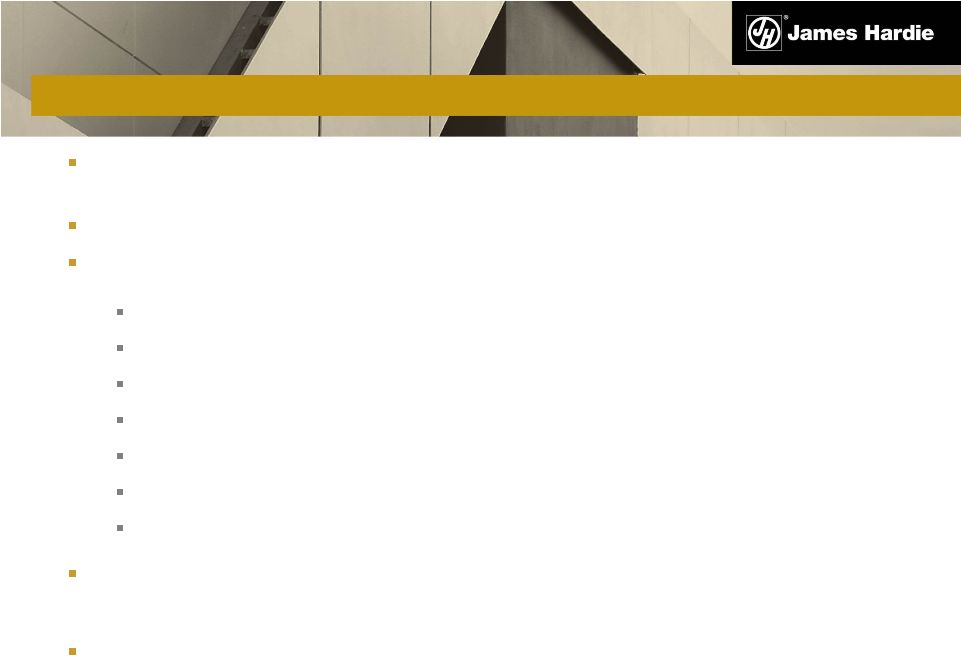 We have a strong, well-established, growth-focused, strong
cash-generating and high return business
We have a sustainable competitive advantage
Our model for strong growth is based on:
Large market opportunity
Superior value proposition
Proprietary and/or protected technology
Ongoing commitment to research and development
Significant organisational advantages
Focused strategy and organisational effort
Scale
Despite the low demand environment the company has performed
exceptionally well, consistently delivering solid financial returns
The company is positioned well to leverage its increased capabilities when a
recovery eventuates
SUMMARY
22 |
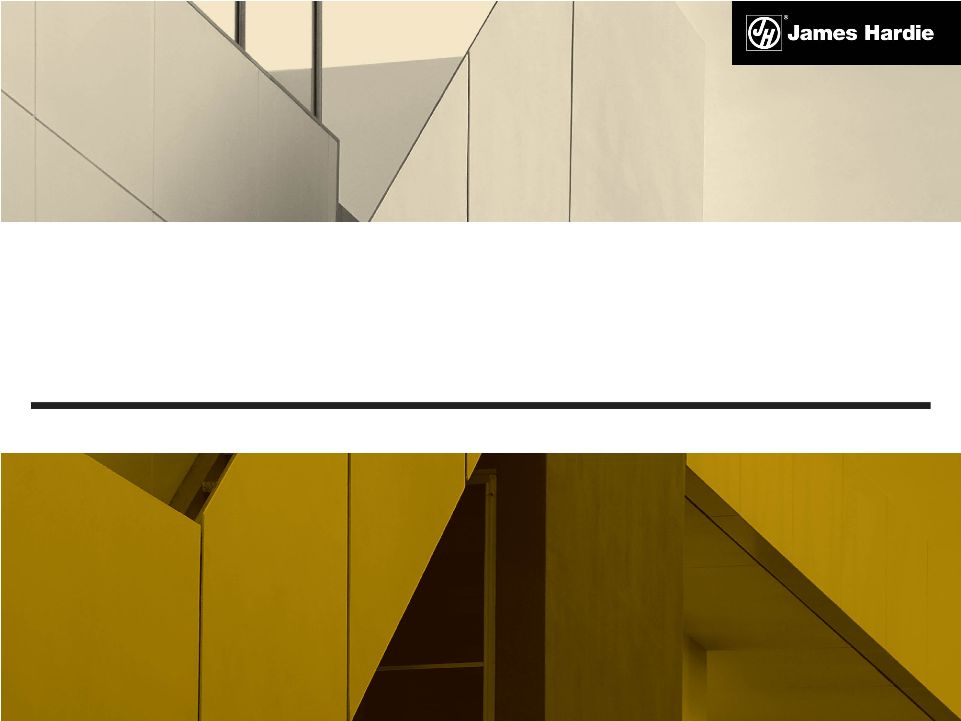 APPENDIX |
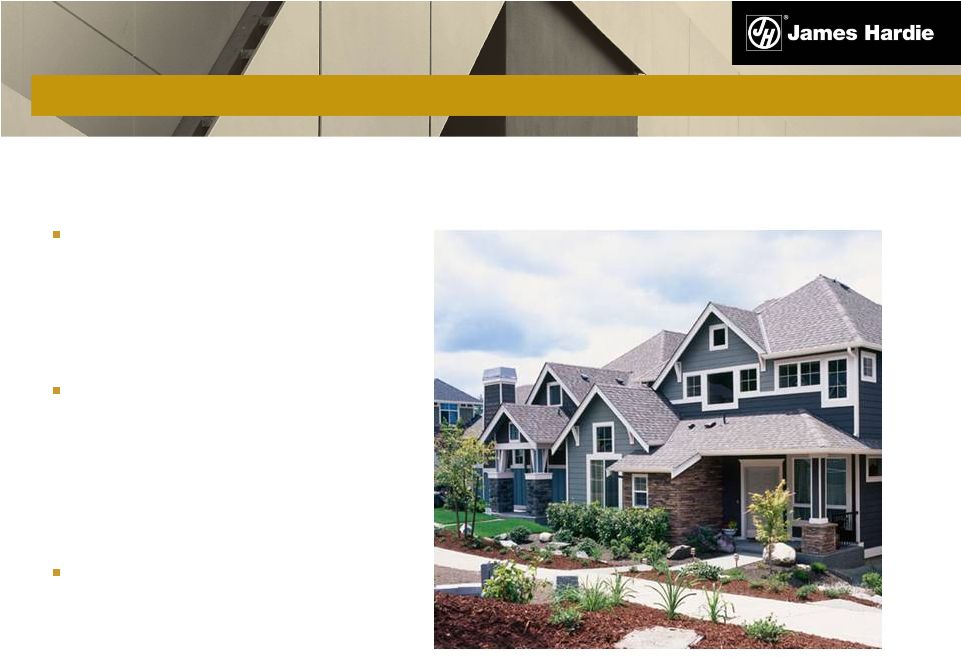 24
Aggressively grow demand
for our products in targeted
market segments
Grow our overall market
position while defending
our share in existing market
segments
Introduce differentiated
products to deliver a
sustainable competitive
advantage
Industry leadership and profitable growth
GLOBAL STRATEGY |
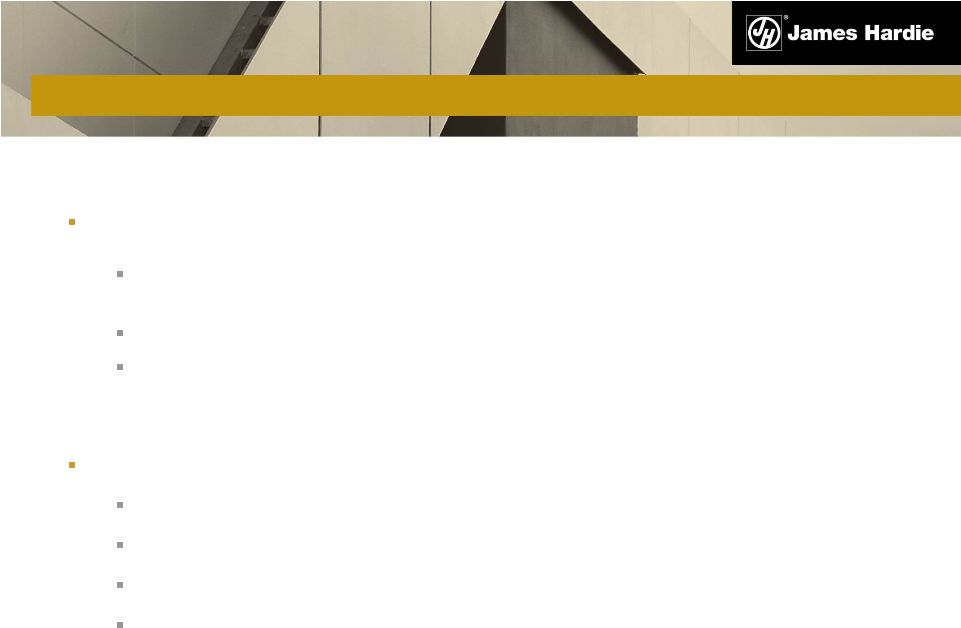 25
GROUP OUTLOOK
Key Priorities
The company’s key medium term priorities in the US are:
Grow
primary
demand
and
exterior
cladding
market
share
–
with
focus
on
repair
and remodel and non-metro markets
Increase market penetration of our ColorPlus®
and Trim products
Continue to rollout our job pack distribution model
Overall Group Strategy
The company’s focus is to:
Deliver primary demand growth
Continue to shift to a higher value product mix
Increase manufacturing efficiency
Build the operational strength and flexibility to deliver and sustain earnings in a
low demand environment and increase output should a stronger than expected
recovery eventuate |
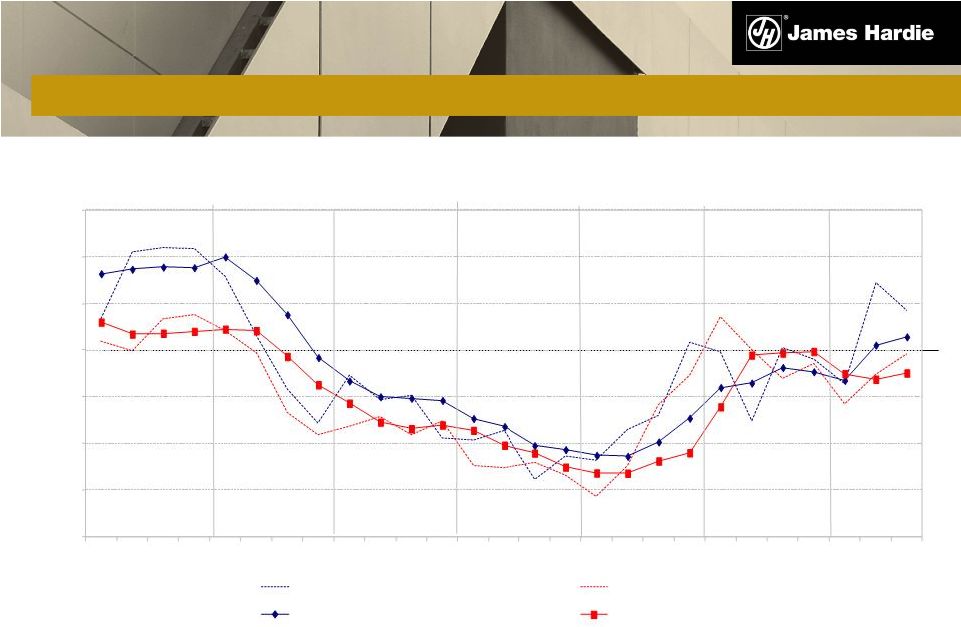 Primary Growth Performance
All market and market share figures are management ‘s estimates.
26
USA AND EUROPE FIBRE CEMENT
-
40%
-
30%
-
20%
-
10%
0%
10%
20%
30%
Q106
Q206
Q306
Q406
Q107
Q207
Q307
Q407
Q108
Q208
Q308
Q408
Q109
Q209
Q309
Q409
Q110
Q210
Q310
Q410
Q111
Q211
Q311
Q411
Q112
Q212
Q312
%JHBP Growth (sdft)
NC/R&R Growth
Rolling 4Qtr -
Rolling 4Qtr -
JHBP Growth (sdft)
NC/R&R Growth |
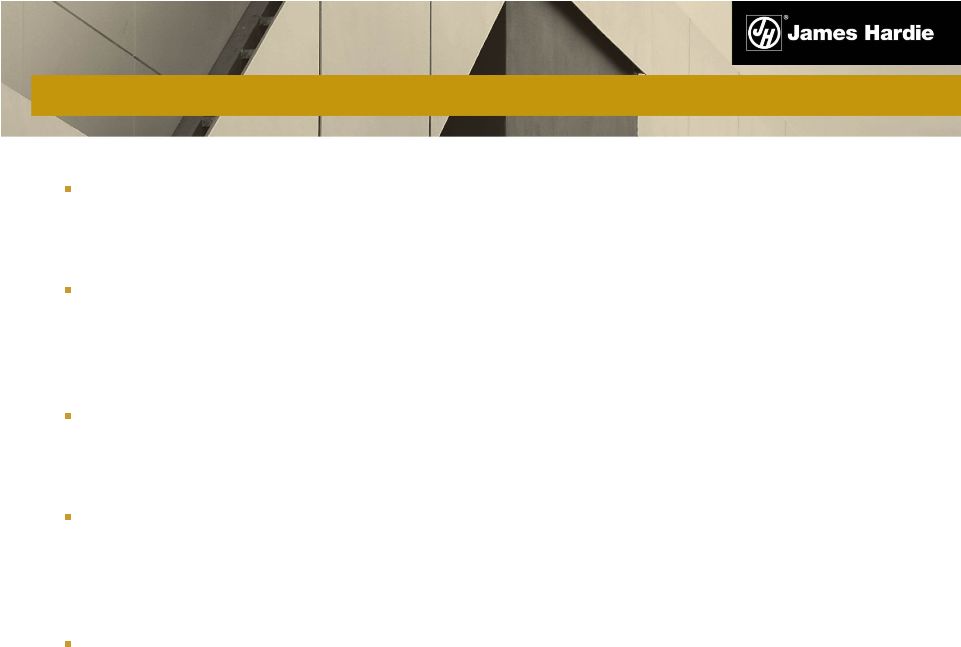 27
GUIDANCE
Challenges remain, with the operating environment in the US still weak and the Asia
Pacific residential markets softening
Management anticipates
FY12 full year earnings excluding asbestos, ASIC expenses
and tax adjustments expected to be within the range of US$130 million to US$140
million
Management cautions that conditions remain uncertain and notes that the cost of
some inputs, particularly pulp and freight, may be volatile
Management cautions that guidance is dependent upon housing industry conditions
and
the
A$/US$
exchange
rate
remaining
stable
for
the
balance
of
the
fiscal
year
ending 31 March 2012
The company continues to perform well financially and our employees remain focused
on driving our long term strategies |
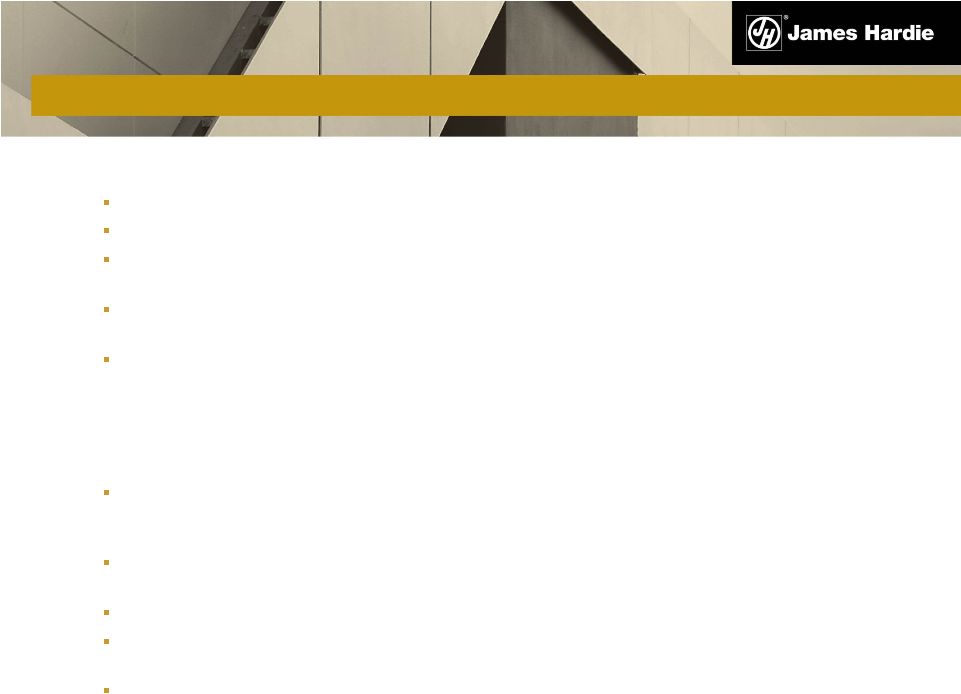 28
LEGACY ISSUES UPDATE
ATO –
RCI successful in its appeal of the 1999 disputed amended tax assessment
James Hardie’s initial appeal dismissed by the Federal Court of Australia in September
2010 Charge
of
US$345.2
million
effective
1
September
2010
(no
impact
on
net
operating
cash
flow
in
FY11)
On 22 August 2011, the Full Federal Court upheld RCI’s appeal, ordered that RCI’s objection
be allowed in full and awarded RCI costs
The ATO filed an application for special leave to appeal the Full Federal Court’s decision to
the High Court of Australia. On 10 February 2012, the High Court dismissed the ATO’s
application. With the matter now finalised in RCI’s favour, the ATO issued a further
notice of amended assessment and
paid
a
refund
of
US$265.8
million
(A$248.0
million)
on
27
February
2012.
Accordingly,
the
fourth
quarter and full year results will reflect a benefit of approximately US$393.8 million (A$367.6
million), which represents the reversal of the provision for the unpaid portion of the amended
assessment and cash paid
by
RCI
during
the
appeal
proceedings,
partially
offset
by
taxes
payable
on
general
interest
charges previously deducted
Additional interest income will be recognised as a benefit in the fourth quarter on amounts which
were overpaid up to 27 February 2012, partially offset by taxes payable on the interest. This
amount is anticipated to be paid by the ATO in the fourth quarter.
The company has commenced recovery of a portion of the legal costs incurred in litigating the amended
assessment
35% of the refund will be contributed to AICF
Company will have Australian tax liability on the reversal of general interest charges, interest
income and legal costs recovered
Management and Board considering options for use of balance of refund |
 *
Certain reclassifications have been reflected in the prior period shown above to conform with current
period presentation 1
Excludes
asbestos
adjustments,
AICF
SG&A
expenses,
AICF
interest
income,
gain
or
impairment
on
AICF
investments, tax benefits related to asbestos adjustments, ASIC expenses/recoveries and tax
adjustments 2
Excludes asbestos adjustments, AICF SG&A expenses and ASIC expenses/recoveries
.
29
KEY RATIOS
*
9 Months
FY2012
9 Months
FY2011
9 Months
FY2010
EPS (Diluted)
24.7c
18.8c
25.3c
EBIT/ Sales (EBIT margin)
16.3%
15.6%
20.1%
Gearing Ratio
-2.0%
4.6%
11.7%
Net Interest Expense Cover
25.6x
24.1x
37.9x
Net Interest Paid Cover
24.8x
22.5x
33.4x
Net Debt Payback
-
0.3yrs
0.5yrs
1
2
1
2
2 |
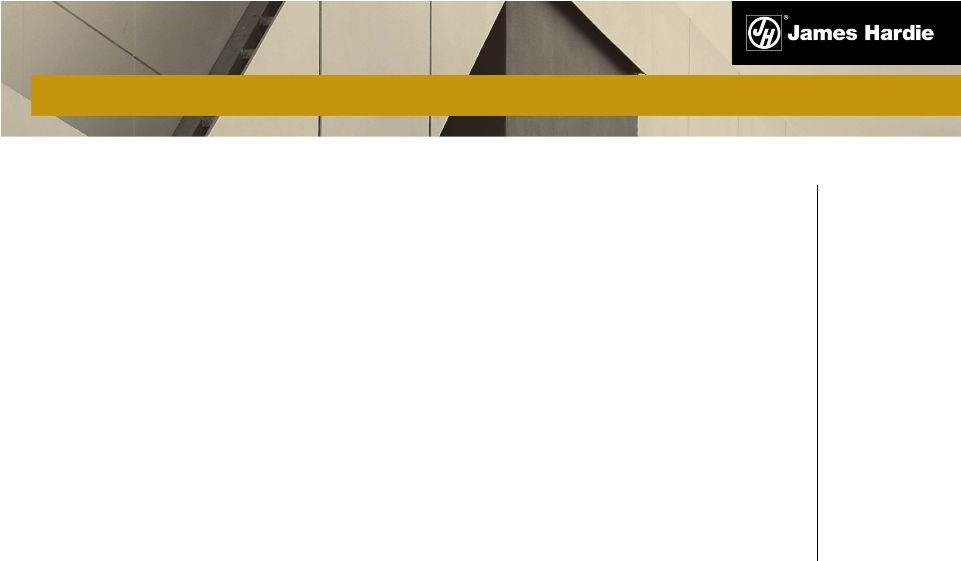 30
USA AND EUROPE 5 YEAR RESULTS OVERVIEW
FY07
FY08
FY09
FY10
FY11
Q3 FY12*
Net Sales
US$m
1,262
1,144
910
828
814
641
Sales Volume
mmsf
2,148
1,916
1,508
1303
1,248
981
Average
Price
US$ per msf
588
597
604
635
652
654
EBIT
US$m
362
313
200
208
160
126
EBIT Margin
%
29
27
22
25
20
20
* For nine months ending 31 December 2011 |
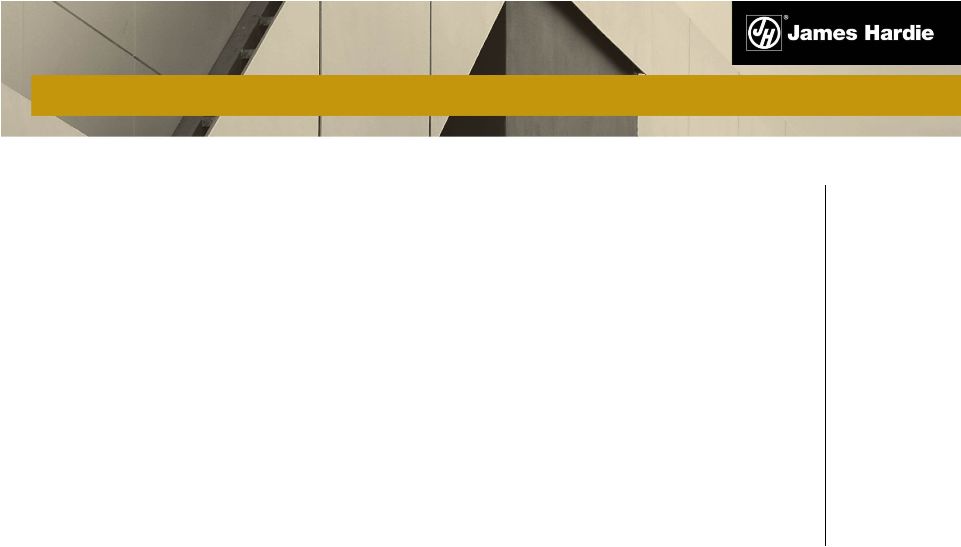 31
ASIA PACIFIC 5 YEAR RESULTS OVERVIEW
FY07
FY08
FY09
FY10
FY11
Q3 FY12*
Net Sales
US$m
223
298
273
296
353
287
Sales Volume
mmsf
390
398
390
389
407
298
Average
Price
A$ per msf
842
862
879
894
916
924
EBIT
US$m
39
50
47
58
79
66
EBIT Margin
%
16
17
17
20
23
23
* For nine months ending 31 December 2011 |
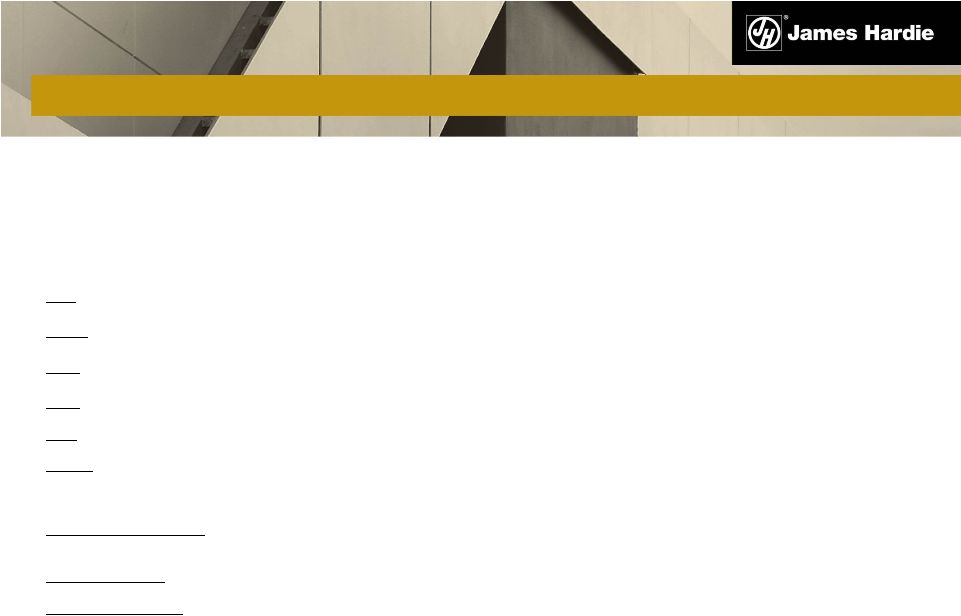 This Management Presentation forms part of a package of information about the
company’s results. It should be read in conjunction with the
other parts of this package, including the Management’s Analysis of Results, Media Release and Condensed
Consolidated Financial Statements.
Definitions
Non-financial Terms
ABS
–
Australian
Bureau
of
Statistics.
AFFA
–
Amended
and
Restated
Final
Funding
Agreement.
AICF
–
Asbestos Injuries Compensation Fund Ltd.
ASIC
–
Australian Securities and Investments Commission.
ATO
–
Australian Taxation Office.
NBSK –
Northern Bleached Soft Kraft; the company's benchmark grade of pulp.
Financial
Measures
–
US
GAAP
equivalents
EBIT
and
EBIT
Margin
-
EBIT, as used in this document, is equivalent to the US GAAP measure of operating
income. EBIT margin is defined as EBIT as a percentage of net sales.
Operating profit
-
is equivalent to the US GAAP measure of income.
Net
operating
profit
-
is
equivalent
to
the
US
GAAP
measure
of
net
income.
32
ENDNOTES |
 Sales Volumes
mmsf
–
million
square
feet,
where
a
square
foot
is
defined
as
a
standard
square
foot
of
5/16”
thickness.
msf –
thousand
square
feet,
where
a
square
foot
is
defined
as
a
standard
square
foot
of
5/16”
thickness.
Financial Ratios
Gearing
Ratio
–
Net
debt
(cash)
divided
by
net
debt
(cash)
plus
shareholders’
equity.
Net interest expense cover
–
EBIT divided by net interest expense (excluding loan establishment fees).
Net
interest
paid
cover
–
EBIT
divided
by
cash
paid
during
the
period
for
interest,
net
of
amounts
capitalised.
Net debt payback
–
Net debt (cash) divided by cash flow from operations.
Net debt (cash)
–
Short-term and long-term debt less cash and cash equivalents.
Return on Capital employed
–
EBIT divided by gross capital employed.
33
ENDNOTES (CONTINUED) |
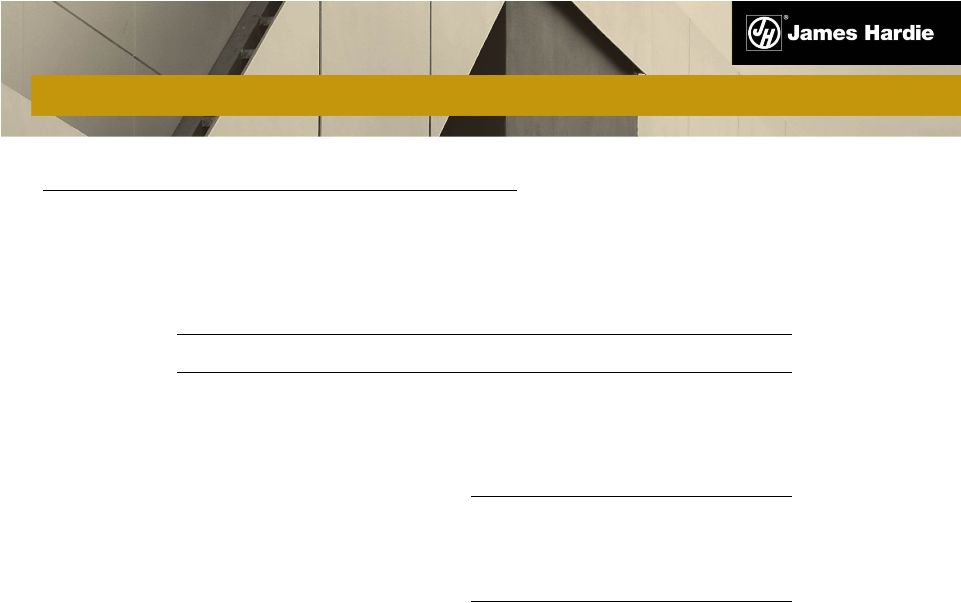 34
NON-US GAAP FINANCIAL MEASURES
EBIT
and
EBIT
margin
excluding
asbestos
and
ASIC
expenses–
EBIT
and
EBIT
margin
excluding
asbestos
and
ASIC
expenses
are
not
measures
of
financial
performance
under
US
GAAP
and
should
not
be
considered
to
be
more
meaningful
than
EBIT
and
EBIT
margin.
Management
has
included
these
financial
measures
to
provide
investors
with
an
alternative
method
for
assessing
its
operating
results
in
a
manner
that
is
focussed
on
the
performance
of
its
ongoing
operations
and
provides
useful
information
regarding
its
financial
condition
and
results
of
operations.
Management
uses
these
non-US
GAAP
measures
for
the
same
purposes.
Q3
Q3
9 Months
9 Months
US$ Millions
FY 2012
FY 2011
FY 2012
FY 2011
EBIT
$ 1.8
$ (16.9)
$ 162.9
$ 53.9
Asbestos:
Asbestos adjustments
33.5
46.4
(15.2)
91.1
AICF SG&A expenses
0.9
0.7
2.3
1.7
ASIC related expenses (recoveries)
0.3
-
1.0
(9.5)
EBIT excluding asbestos and ASIC expenses
36.5
30.2
151.0
137.2
Net sales
$ 283.0
$ 272.6
$ 928.2
$ 878.6
EBIT margin excluding asbestos and
ASIC expenses
12.9%
11.1%
16.3%
15.6% |
 Net
operating profit excluding asbestos, ASIC expenses and tax adjustments–
Net operating profit excluding asbestos,
ASIC expenses and tax adjustments is not a measure of financial performance under
US GAAP and should not be considered
to
be
more
meaningful
than
net
income.
Management
has
included
this
financial
measure
to
provide
investors
with an alternative method for assessing its operating results in a manner that is
focussed on the performance of its ongoing operations. Management uses this
non-US GAAP measure for the same purposes. 35
NON-US GAAP FINANCIAL MEASURES (CONTINUED)
¹
The nine month results of the prior year included a charge of US$345.2 million resulting from the
dismissal by the Federal
Court of Australia of RCI’s appeal of the ATO’s disputed 1999 amended
assessment. Readers are referred to Note 10 of the condensed
consolidated financial statements for further information.
Q3
Q3
9 Months
9 Months
US$ Millions
FY 2012
FY 2011
FY 2012
FY 2011
Net operating (loss) profit
$ (4.8)
$ (26.4)
$ 123.6
$ (345.2)
Asbestos:
Asbestos adjustments
33.5
46.4
(15.2)
91.1
AICF SG&A expenses
0.9
0.7
2.3
1.7
AICF interest income
(0.8)
(0.7)
(2.2)
(2.4)
Tax expense related to asbestos
adjustments
(0.1)
-
(0.1)
0.6
ASIC related expenses (recoveries)
0.3
-
1.0
(9.5)
Tax adjustments ¹
(1.3)
1.0
(1.1)
345.9
Net operating profit excluding asbestos,
ASIC expenses and tax adjustments
$ 27.7
$ 21.0
$ 108.3
$ 82.2 |
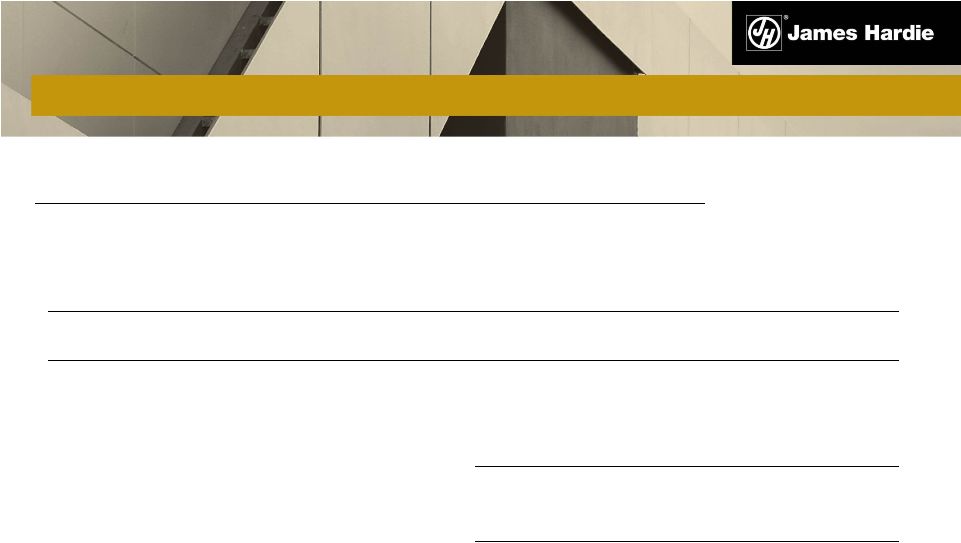 Non-US GAAP Financial Measures (continued)
Diluted
earnings
per
share
excluding
asbestos,
ASIC
expenses
and
tax
adjustments–
Diluted
earnings
per
share
excluding asbestos, ASIC expenses and tax adjustments is not a measure of financial
performance under US GAAP and should not be considered to be more meaningful
than diluted earnings per share. Management has included this financial
measure to provide investors with an alternative method for assessing its operating
results in a manner that is focussed on the performance of its ongoing
operations. Management uses this non-US GAAP measure for the same purposes.
36
NON-US GAAP FINANCIAL MEASURES (CONTINUED)
Q3
Q3
9 Months
9 Months
US$ Millions
FY 2012
FY 2011
FY 2012
FY 2011
Net operating profit excluding asbestos,
ASIC expenses and tax adjustments
$ 27.7
$ 21.0
$ 108.3
$ 82.2
Weighted average common shares outstanding -
Diluted (millions)
437.0
438.0
438.4
437.7
Diluted earnings per share excluding asbestos,
ASIC expenses and tax adjustments
(US cents)
6.3
4.8
24.7
18.8 |
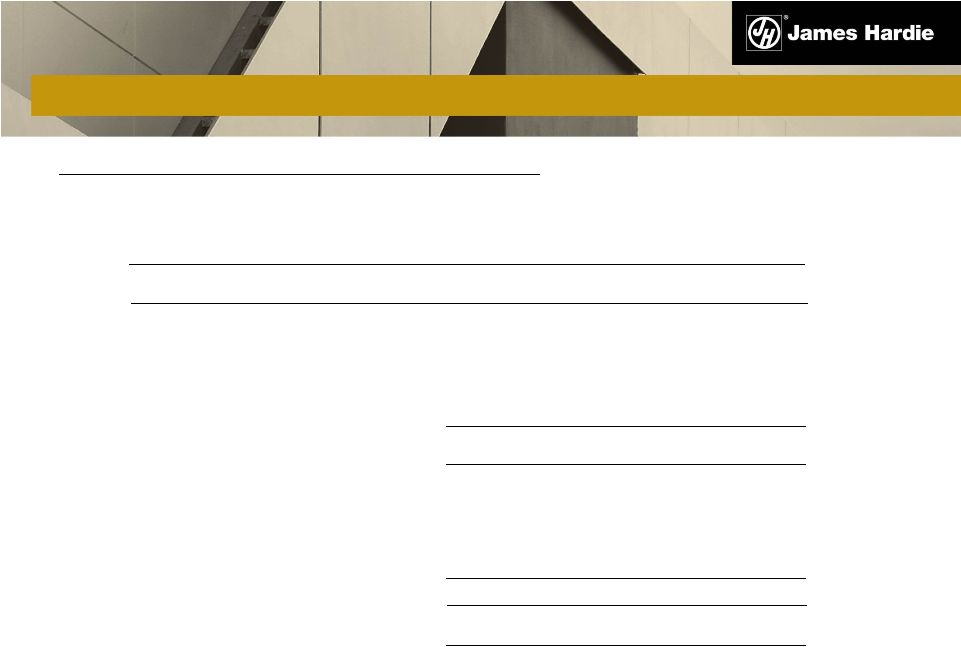 Effective
tax
rate
excluding
asbestos
and
tax
adjustments–
Effective
tax
rate
excluding
asbestos
and
tax
adjustments is not a measure of financial performance under US GAAP and should not
be considered to be more meaningful
than
effective
tax
rate.
Management
has
included
this
financial
measure
to
provide
investors
with
an
alternative method for assessing its operating results in a manner that is focussed
on the performance of its ongoing operations. Management uses this
non-US GAAP measure for the same purposes. 37
NON-US GAAP FINANCIAL MEASURES (CONTINUED)
Q3
Q3
9 Months
9 Months
US$ Millions
FY 2012
FY 2011
FY 2012
FY 2011
Operating profit (loss) before income taxes
$ 1.8
$ (15.5)
$ 158.7
$ 46.0
Asbestos:
Asbestos adjustments
33.5
46.4
(15.2)
91.1
AICF SG&A expenses
0.9
0.7
2.3
1.7
AICF interest income
(0.8)
(0.7)
(2.2)
(2.4)
Operating profit before income taxes excluding
asbestos
$ 35.4
$ 30.9
$ 143.6
$ 136.4
Income tax expense
(6.6)
(10.9)
(35.1)
(391.2)
Asbestos:
Tax expense related to asbestos adjustments
(0.1)
-
(0.1)
0.6
Tax adjustments ¹
(1.3)
1.0
(1.1)
345.9
Income tax expense excluding tax adjustments
(8.0)
(9.9)
(36.3)
(44.7)
Effective tax rate excluding asbestos and
tax adjustments
22.6%
32.0%
25.3%
32.8%
¹ The nine month results of the prior year included a charge of US$345.2 million
resulting from the dismissal by the Federal
Court of Australia of RCI’s appeal of the ATO’s disputed 1999 amended
assessment. Readers are referred to Note 10 of the condensed consolidated financial statements for further information. |
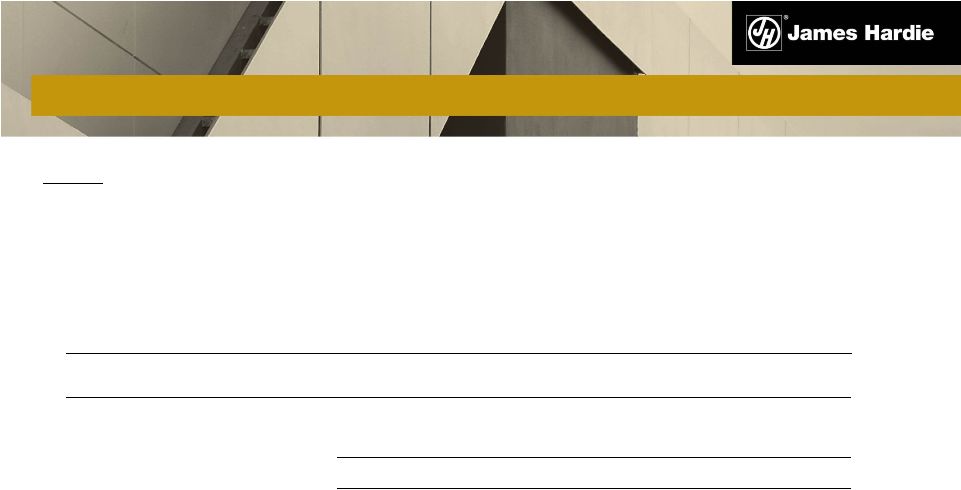 EBITDA–
is not a measure of financial performance under US GAAP and should not be
considered an alternative to, or more
meaningful
than,
income
from
operations,
net
income
or
cash
flows
as
defined
by
US
GAAP
or
as
a
measure of
profitability or liquidity. Not all companies calculate EBITDA in the same manner
as James Hardie has and, accordingly, EBITDA may not be comparable with
other companies. Management has included information concerning EBITDA because
it believes that this data is commonly used by investors to evaluate the ability of
a company’s earnings from its core business
operations
to
satisfy
its
debt,
capital
expenditure
and
working
capital
requirements.
38
NON-US GAAP FINANCIAL MEASURES (CONTINUED)
Q3
Q3
9 Months
9 Months
US$ Millions
FY 2012
FY 2011
FY 2012
FY 2011
EBIT
$ 1.8
$ (16.9)
$ 162.9
$ 53.9
Depreciation and amortisation
17.0
15.9
47.8
46.9
Adjusted EBITDA
$ 18.8
$ (1.0)
$ 210.7
$ 100.8 |
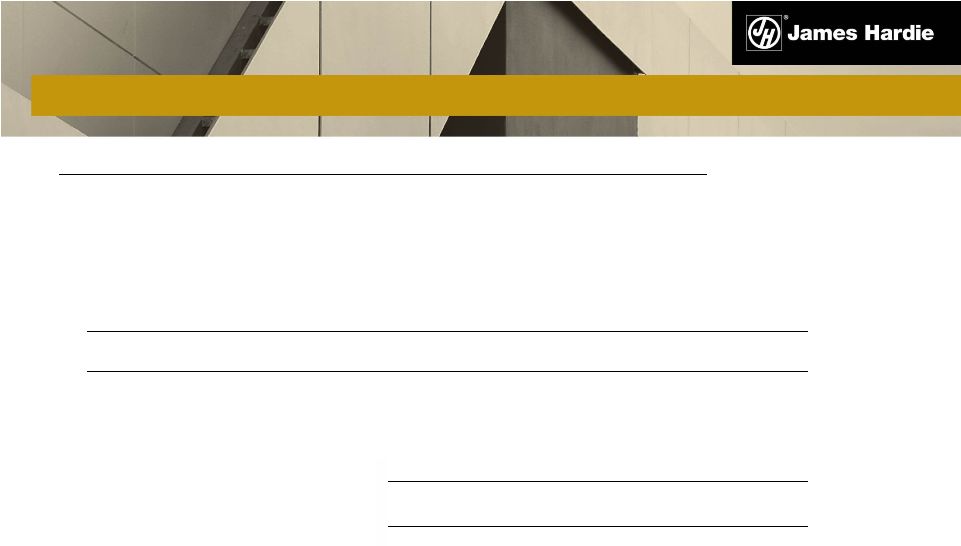 General corporate costs excluding ASIC expenses and domicile change related
costs– General corporate costs
excluding
ASIC
expenses
and
domicile
change
related
costs
is
not
a
measure
of
financial
performance
under
US
GAAP
and should not be considered to be more meaningful than general corporate costs.
Management has included these financial measures to provide investors with
an alternative method for assessing its operating results in a manner that is
focussed on the performance of its ongoing operations and provides useful
information regarding its financial condition and results of operations.
Management uses these non-US GAAP measures for the same purposes. 39
NON-US GAAP FINANCIAL MEASURES (CONTINUED)
Q3
9 Months
9 Months
US$ Millions
FY 2011
FY 2011
General corporate costs
$ 9.2
$ 12.1
$ 27.1
$ 21.1
Excluding:
ASIC related (expenses) recoveries
(0.3)
-
(1.0)
9.5
Domicile change related costs
-
-
-
(1.8)
General corporate costs excluding ASIC
expenses and domicile change related costs
$ 8.9
$ 12.1
$ 26.1
$ 28.8
FY 2012
Q3
FY 2012 |